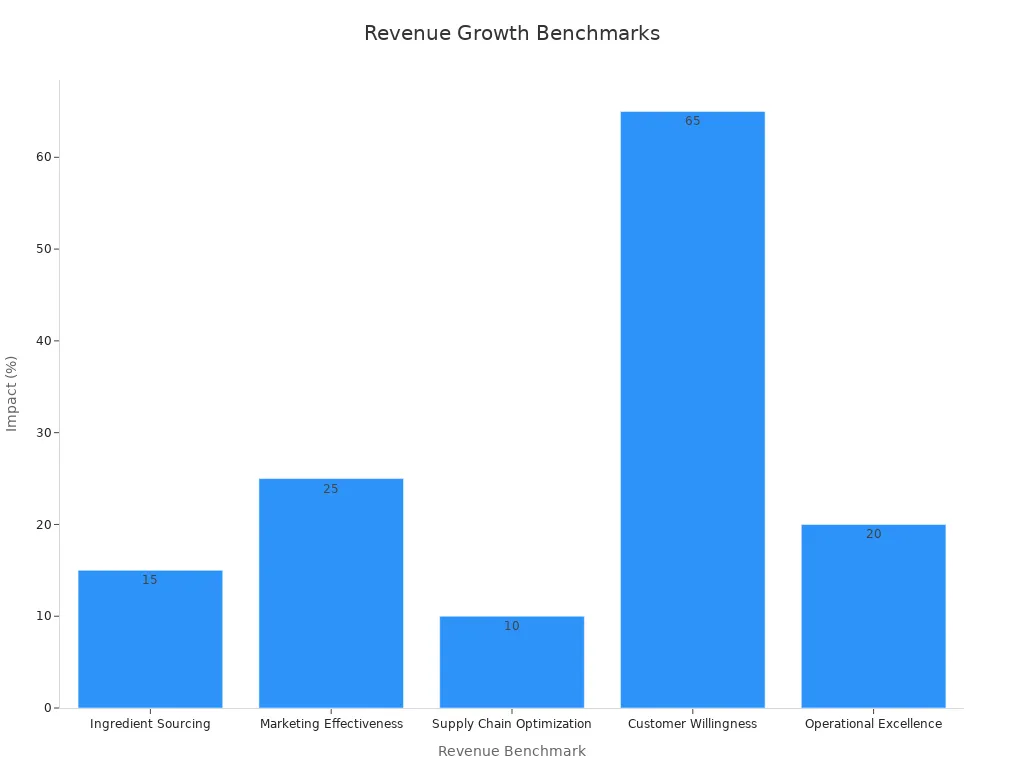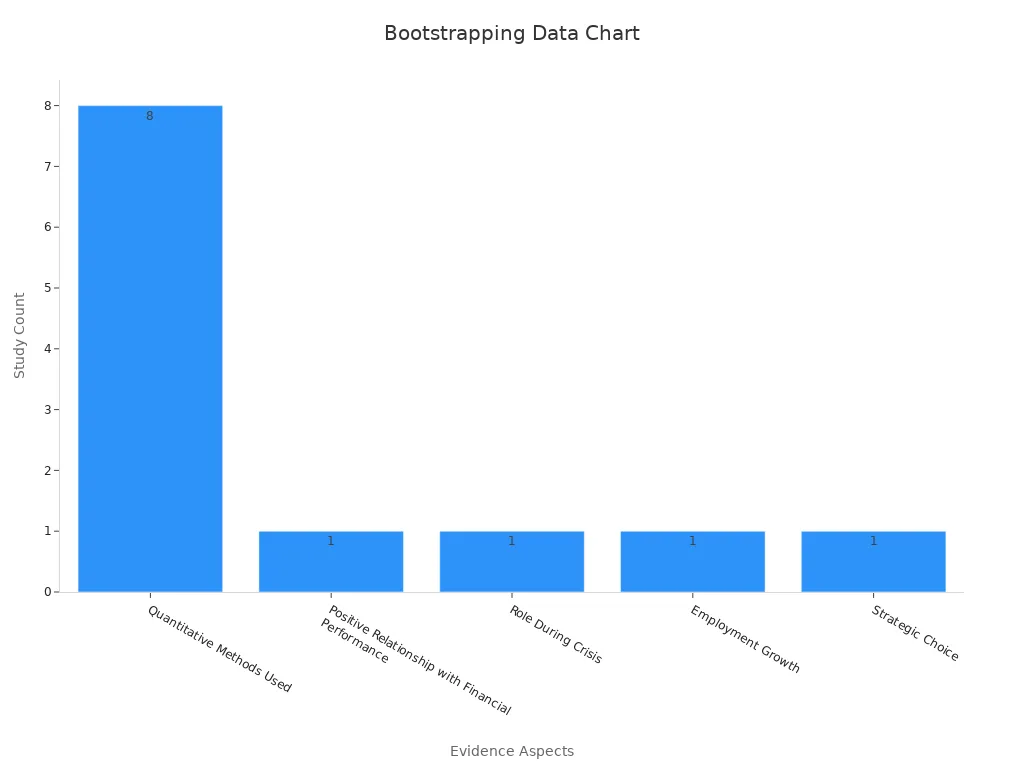How Founders Can Reach Ramen Profitable Faster

Ramen profitable means your startup earns enough to cover your basic living expenses. For most entrepreneurs, this is the first big milestone. You feel less stress when you know your rent, food, and essentials are paid. Many founders set their ramen profitable target by looking at salary ranges and local costs. The table below shows typical numbers:
Metric Category | Numerical Range / Value | Explanation |
|---|---|---|
Typical Salary Ranges | $0 - $75,000 | Bootstrapped ($0-50k), friends & family ($40-60k), pre-seed ($50-75k) |
Capital Allocation to Salaries | 15% - 25% of available capital | Portion of funds used for founder salaries |
Location Cost Adjustments | +50% to +75% (San Francisco) | Adjust salaries for high-cost cities |
Reaching ramen profitability gives you freedom and focus. You can move faster and make better decisions.
Key Takeaways
Ramen profitability means your startup earns enough to cover your basic living costs, giving you freedom and focus to build your business.
Set a clear monthly revenue target by adding up your essential expenses like rent, food, and insurance to know when you reach ramen profitability.
Grow your revenue fast by solving real problems, charging customers early, and using smart marketing tactics like influencer partnerships and targeted ads.
Cut expenses aggressively by working lean, using affordable tools, and lowering living costs to stretch your runway and stay in control.
Avoid common startup mistakes by validating demand, managing finances well, listening to customers, and building clean, scalable systems from the start.
Ramen Profitability Explained

What Is Ramen Profitability?
Ramen profitability means your startup earns just enough to cover your basic living expenses. You do not need outside funding to survive. This concept became popular when Paul Graham of Y Combinator described how a startup can stay alive by making enough money for founders to pay rent and buy food. You focus on survival, not luxury.
You can see how ramen profitability works in different places:
Location | Expense Breakdown / Notes | |
|---|---|---|
UK | $5,000 MRR | Covers rent, bills, meals; assumes taxes and profit margin |
Bali | $1,200 | Includes taxes, rent, food, and basic extras |
Europe (general) | ~€1,500 MRR | Reflects higher rent costs |
Thailand | ~$2,000 MRR | Lower cost of living allows a lower income level |
You set your ramen profitability target by adding up your minimum living costs. This number is your first big milestone as a founder. Many early-stage startups use this goal to measure progress.
Tip: Ramen profitability is not about getting rich. It is about staying in the game long enough to build something great.
Why Ramen Profitability Matters
Ramen profitability gives you freedom. You do not have to chase investors just to pay your bills. You can focus on building your product and talking to customers. The Lean Startup method, created by Eric Ries, highlights how startups use ramen profitability to test ideas quickly and save resources. You can try new things, learn fast, and improve your product.
Here are some reasons why ramen profitability is important for early-stage startups:
You avoid fear-driven decisions and work with passion.
You show discipline by managing expenses well.
You improve team morale and keep everyone focused.
You get better fundraising terms if you choose to raise money later.
You can invest profits to grow faster.
Many investors, like Peter Thiel, notice that founders who pay themselves only a "ramen salary" often succeed more. They stay committed and put the business first. Still, you need enough income to avoid burnout and stay healthy.
The importance of ramen profitability is clear. Startups that reach this point early have a better chance of surviving. Good cash flow and cost control help you handle tough times and keep your startup alive.
How to Become Ramen Profitable
Set Your Ramen Profitability Target
You need a clear target before you can reach ramen profitability. Start by adding up your basic living expenses. Include rent, food, utilities, and health insurance. This number is your minimum monthly recurring revenue. Use break-even analysis to see how much you must earn to cover these costs. Sales forecasting helps you predict future income based on market trends and past data. Profit margin analysis shows if your pricing supports your goal. Cash flow forecasting ensures you have enough money each month.
Market benchmarks help you set realistic goals. Track your customer acquisition cost, lifetime value, and the LTV:CAC ratio. Most early-stage startups aim for a 3:1 ratio. Monitor your burn rate and runway to know how long your cash will last. Investors like to see a runway of 12 to 18 months. Monthly recurring revenue is a key metric. It shows if your startup can support your living expenses. Set a plan with clear steps and timelines. Review your plan every quarter to adjust for changes.
Tip: Use a simple table or dashboard to track your expenses and revenue targets. This keeps your plan visible and easy to update.
Track Your Progress
Tracking progress is vital for ramen profitability. Use analytics tools to gather customer data from surveys, social media, and sales reports. Analyze this data to spot trends and improve your product. Get real feedback from early users to refine your offering. Test your MVP with select customers before a full launch. Monitor key performance indicators like monthly recurring revenue, customer retention, and operational efficiency.
Set short-term and long-term revenue targets. For example, aim for $50,000 per month in the first quarter, then $200,000 after 18 months. Track customer satisfaction and retention rates. High retention means your product meets real needs. Use real-time dashboards to watch your cash flow and profit margins. Review your plan at least twice a year. Adjust your strategy as you learn from the data.
A data-driven plan helps you make better decisions. Companies that use data-driven strategies are much more likely to become profitable. You build a profitable company by focusing on the right metrics and acting on what you learn.
Achieving Ramen Profitability Fast
Increase Revenue Quickly
You need to focus on revenue growth from day one. The fastest way to achieve ramen profitability is to validate a real problem and get paying customers as soon as possible. Start by talking directly to your target users. Ask about their biggest pain points. Build a simple MVP that solves one burning problem. Use a tool like Momen to launch an MVP in days, not weeks. This lets you test your idea and get feedback without heavy investment.
Charge for your product early. Even a small monthly fee shows that customers value your solution. Canny, a SaaS startup, reached ramen profitability in just seven months by charging $19 per month from the start. They grew their monthly recurring revenue from zero to $3,500 in the first year. They did this by validating the problem, launching on Product Hunt, and building an inbound marketing funnel. You can follow a similar path by focusing on:
Charging early and often to confirm demand.
Targeting high-value customers who need your solution most.
Using influencer partnerships to boost trust and conversion rates by up to 25%.
Running targeted online ads to increase ad effectiveness by 15-30%.
Launching with user-friendly e-commerce or subscription models to drive consistent revenue.
Leveraging word-of-mouth and organic channels for cost-effective growth.
Tip: Launching early helps you learn what works. You can adjust your pricing, features, and marketing based on real customer feedback.
Financial models help you plan for fast growth. Use scenario planning and sensitivity analysis to test different pricing strategies and customer acquisition channels. Track your monthly recurring revenue, churn, and unit economics. This approach supports realistic revenue projections and helps you make better decisions.
Here is a table of success metrics that show how different strategies can help you grow faster:
Success Metric | Impact / Improvement | Explanation |
|---|---|---|
Influencer Partnerships | Enhances consumer trust and accelerates market penetration | |
Targeted Online Ads | 15-30% growth in ad effectiveness | Improves ROI through precise demographic targeting |
User-Friendly E-Commerce | 25% increase in site conversions | Direct customer engagement reduces distribution fees |
Subscription Growth Rate | 20% increase | Provides consistent revenue streams and improves customer retention |
Loyalty Programs | 15% boost in repeat sales | Enhances repeat purchase rates and sustained revenue growth |
Direct-to-Consumer Sales | Up to 30% potential profit margin improvement | Lowers production and distribution costs, increasing margins |
Sales Volume Growth | Steady 20% annual growth | Boosts overall profitability by leveraging economies of scale |
Profit Margin Range | 15% to 40% | Indicates profitability improvements through various strategies |
You can see that focusing on the right growth tactics leads to higher monthly recurring revenue and faster progress toward ramen profitability.
Cut Expenses Aggressively
Cutting costs is just as important as growing revenue. Many founders achieve ramen profitability by keeping expenses low. You can do this by adopting a digital nomad lifestyle, working from places with a lower cost of living. Canny’s founders moved to reduce their living expenses, which helped them sustain the business on modest revenue.
Use free or affordable tools to run your business. Momen lets you build, launch, and manage your app without hiring a large development team. You save on setup, hosting, and maintenance costs. Momen’s built-in automation and real-time dashboards improve productivity and help you track spending. You can monitor expenses, flag waste, and enforce spending policies automatically.
Here are some proven cost-saving strategies:
Cost-Saving Strategy | Cost/Benefit Impact |
|---|---|
Mixing specialists and generalists | Reduces development costs by 30-70% |
Outsourcing vs. in-house development | Saves approximately $100,000 annually |
Automation (e.g., Zapier) | Overhead savings of $500,000+ annually |
Cloud-based communication tools (Slack) | Boosts productivity by 47%, with 90% users reporting improved connectivity |
You can also use digital tools to track and rate expenses in real time. Predictive analytics and benchmarking help you spot overspending and find new ways to save. Momen’s automation features let you focus on building your product, not managing infrastructure.
Many startups reach ramen profitability with monthly revenues as low as $5,000 by keeping costs down and staying involved in every part of the business. This approach validates your product-market fit and gives you the freedom to grow at your own pace.

Note: Ramen profitability is not about cutting corners. It is about making smart choices so you can survive and thrive.
By combining rapid revenue growth with aggressive expense reduction, you set yourself up for success. Use tools like Momen to launch, iterate, and operate efficiently. Focus on getting paying customers, optimizing pricing, and improving productivity every step of the way. Achieving ramen profitability fast gives you the confidence and independence to build a lasting business.
Bootstrapping to Ramen Profitability

Avoiding Technical Debt from Day One
You want your startup to move fast, but you also need to build a strong foundation. Technical debt happens when you take shortcuts in your code or systems. Over time, this can slow you down and cost more to fix. Research shows that reducing technical debt early can improve software reliability by 25% and cut post-release defects by 30%. Using tools like Momen helps you avoid these problems. Momen gives you instant deployment, automated CI/CD, and real-time logging. These features let you launch quickly and keep your code clean. You can track important metrics like cycle time, deployment frequency, and defect density. This keeps your systems scalable and easy to maintain.
Tip: Clean, scalable systems save you money and time. You spend less on fixing bugs and more on building features your customers want.
Avoid Common Pitfalls
Many founders make the same mistakes when building a startup. You can avoid these by staying focused and learning from others. Here are some common pitfalls:
Not validating market demand
Poor financial management
Weak founding team
Ineffective marketing and sales
Ignoring regulations
Focusing only on product, not sales
Forgetting about customer retention
Poor product-market fit
Trouble accessing capital
Founder conflicts
Weak business planning
Ignoring unit economics
Not listening to customer feedback
Expanding too fast
No clear competitive edge
A bootstrapped startup often succeeds by focusing on direct sales, manual customer acquisition, and founder hustle. You keep your operations lean and avoid overbuilding. Lean operations help you reach profitability faster, as seen in companies like Dell and IKEA.
Lean Operation Principle | Company Example | Correlation to Faster Profitability |
|---|---|---|
Streamlined Processes | Toyota | Just-In-Time production reduces waste and increases efficiency, speeding up profitability. |
Cost-Effective Resource Management | Dell | Direct-to-consumer sales model lowers costs and improves cash flow. |
Customer-Centric Product Development | Apple | Focus on feedback avoids costly features and speeds up profits. |

Bootstrapping to ramen profitability gives you control and flexibility. Studies show that bootstrapping is not just a last resort. Many founders choose it to stay efficient and independent. You can use Momen to avoid technical debt, iterate quickly, and build scalable solutions from the start. This approach helps your startup survive and thrive.
Reaching ramen profitability gives entrepreneurs the freedom to survive and build with confidence. Focus on these steps:
Set a clear target for your minimum expenses.
Grow revenue and cut costs aggressively.
Use tools like Momen to speed up your journey.
Entrepreneurs who track cash runway, burn rate, and churn rate avoid the fate of the 29% who fail from running out of cash. After reaching ramen profitability, monitor monthly recurring revenue and profit margins to maintain discipline and support long-term growth. Stay focused on survival first, then scale.
FAQ
What is the fastest way to reach ramen profitability?
You should focus on solving a real problem and charge customers early. Use tools like Momen to launch your MVP quickly. Get feedback, improve your product, and keep your expenses low.
How do I set my ramen profitability target?
Add up your basic living costs, such as rent, food, and insurance. This total becomes your monthly revenue goal. Use a simple table or spreadsheet to track your expenses and income.
Can I use no-code tools like Momen for my startup?
Yes! Momen lets you build and launch web apps without coding. You save time and money. You can test ideas, get feedback, and scale your product as your business grows.
What are common mistakes founders make before ramen profitability?
Ignoring customer feedback
Overbuilding features
Not tracking expenses
Delaying product launch
Stay focused on your main goal: covering your living costs and learning from real users.
